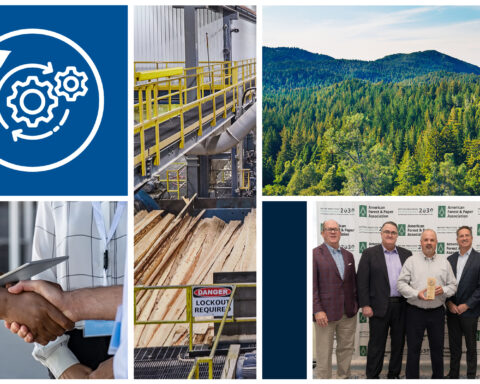This article is “sponsored content” as defined by Corporate Knights’ content disclosure policy.
As the number of severe weather events continues to rise across Canada and globally, it’s evident the fight against climate change is a constant threat to our world’s health, safety, and sustainability.
At the recent United Nations COP26 climate summit in Glasgow, diplomats from nearly 200 countries struck a major agreement to increase the fight against climate change — establishing a consensus that more must be done to protect the planet.
Canada is making strides to address climate change, pledging ambitious commitments to accelerate a path towards a safe and prosperous net-zero future by 2050. But achieving a net-zero future requires every sector of the economy play a role, not just government. Real, lasting, and impactful change that is enough to stop global temperatures from increasing requires collective action, spanning the public and private sectors, policy makers, and ordinary citizens. Collaboration is the best chance we have of creating a more sustainable, electrified world.
“[Climate change] is top of mind across most organizations today and something we must pay close attention to,” said Adrian Thomas, president of Schneider Electric Canada, in a recent leadership panel. Joined by executives from HP Canada, BGIS and Ivanhoé Cambridge. These companies are working across sectors to bring businesses together in their ambitions to address climate change.
While Schneider Electric has continuously raised the bar on transitioning to a green, circular, low-carbon and profitable business model, there is a growing need for all business leaders to act and do more — and stakeholders, including employees, are demanding it.
A recent Willis Tower Watson survey shows that 81 percent of employees believe it’s important for organizations to integrate climate strategy in their employee-value proposition. The survey also shows a third of respondents believe executive compensation should be tied to delivery of climate strategy, while nearly half of employers expect their employees to play a role executing these actions.
The benefits of increasing sustainability are “exponential” and go beyond lowering emissions, Thomas says. “Reducing carbon, in almost all cases, means you’re also being more efficient with the resources that you’re using. So fundamentally, that’s helping your bottom line.”
It also attracts investors: An Edelman survey shows 95 percent of institutional investors believe a company with strong environmental, social and governance (ESG) performance deserves a premium valuation for its share price.
Here are three ways corporate leaders can step up their activities to fight climate change:
Effective goal setting
Having a net-zero business model that is realistic, achievable, measurable, and science-based is critical for organizations to make meaningful change.
Thomas says organizations should start by measuring their current footprints, using well-established reporting metrics, and identifying the major emission sources. “From there, you can start to address where to make improvements and how to make the transition.”
To remain accountable, he says organizations also need to be transparent with their goals by making the results public and updating them regularly.
“Transparency adds weight,” he says. “It’s about doing more than saying ‘we want to be a sustainable company,’ but really committing to those targets.”
It’s a journey Schneider Electric started about 15 years ago, with a commitment to take urgent action to co-create a brighter future aligned with the United Nations Sustainable Development Goals. The company publishes a sustainability report annually and makes it public.
“This is part of our company ethos; this is who we are, it’s part of our core values,” Thomas says. “It helps drive us to do more and to do better.”
Schneider Electric’s current targets include achieving carbon neutrality in its extended ecosystem by 2025 and setting net-zero operational emissions by 2030. It also plans to derive 80 percent of its revenue from green solutions by 2025, have 1,000 of its top suppliers reduce CO2 emissions by 50 percent by 2025 and have an entirely net-zero supply chain by 2050.
Reducing carbon, in almost all cases, means you’re also being more efficient with the resources that you’re using. So fundamentally, that’s helping your bottom line.
-Adrian Thomas
Be selective with suppliers
Tackling sustainability beyond an organization’s own operations – across the supply chain – is the next big challenge.
According to the Carbon Disclosure Project (CDP) supply chain emissions are more than 11 times higher on average than operational emissions — and can be even larger in industry segments like retail, apparel and services. The CDP also warns that organizations are facing up to US$120 billion in costs from environmental risks in their supply chains by 2025.
Supply chain engagement is critical for companies to reduce climate and operational risk, Thomas says, adding that Schneider Electric does this with its suppliers.
“It’s a very supportive circle of work that includes some of our suppliers and our customers that are on the same journey,” he says, adding that Schneider Electric also shares its technology solutions that can help organizations achieve decarbonization targets. “The whole digitalization journey goes hand-in-hand with decarbonization: they support each other.”
Engaging with suppliers also helps to set expectations and drive broader improvements across industry, Thomas adds.
“It’s a connected chain. If we’re going to reduce emissions across the supply chain, we must make it clear what the requirements are to our suppliers,” he says. “By having a dialogue with suppliers and setting expectations, you will see different companies start to adapt and bring on sustainability practices that will help them continue to thrive in a market that’s really demanding it.”
Frances Edmonds, HP Canada’s Head of Sustainability reinforced Thomas’ point, noting the tensions which can arise in supply chain relationships. For example, when a firm has targets set on more ambitious timelines than their suppliers, or when a company’s purchasing power is diluted down the supply chain (i.e., with firms they don’t buy from directly). Both Edmonds and Thomas emphasized the importance of taking a collaborative approach to overcoming these challenges.
Edmonds also listed urgency and improved reporting metrics as pillars to focus on when making supply chains more sustainable. Thomas added the importance of communicating targets with employees, who make decisions every day that affect both sustainability and the bottom line.
Tie executive compensation to ESG performance
It’s not enough for organizations to set and chip away at sustainability targets. Key stakeholders such as employees and shareholders are looking to hold business leaders accountable to steer their companies towards achieving their ESG goals.
Research finds 58 percent of Canadian institutional investors said that linking executive compensation to ESG target performance “greatly impacts” their trust in a company. The Willis Watson survey also shows 43 percent of employers have implemented, started to implement, or are considering climate metrics for their executive incentive plans, while another 27 percent may consider these in the future.
Moving the needle on climate change requires innovative approaches in every corporate boardroom, Thomas says.
Schneider Electric, for example, ties executive compensation to ESG performance and makes the results public. It’s both an incentive and a reward he believes helps organizations move forward more aggressively on decarbonization and other sustainability goals.
“What we have in our sustainability targets lines up with what the executives have in their targets and then that modulates a portion of that cash bonus piece,” he says.
It’s time to lead
The onus is on business leaders to acknowledge the business imperative for addressing the climate crisis head-on.
“We need to get everyone on board with awareness of this critical issue,” Thomas says.
He says decision-makers have a responsibility to lead their companies in the fight against climate change to create truly sustainable organizations that will have a global and societal impact now, and for the future.







